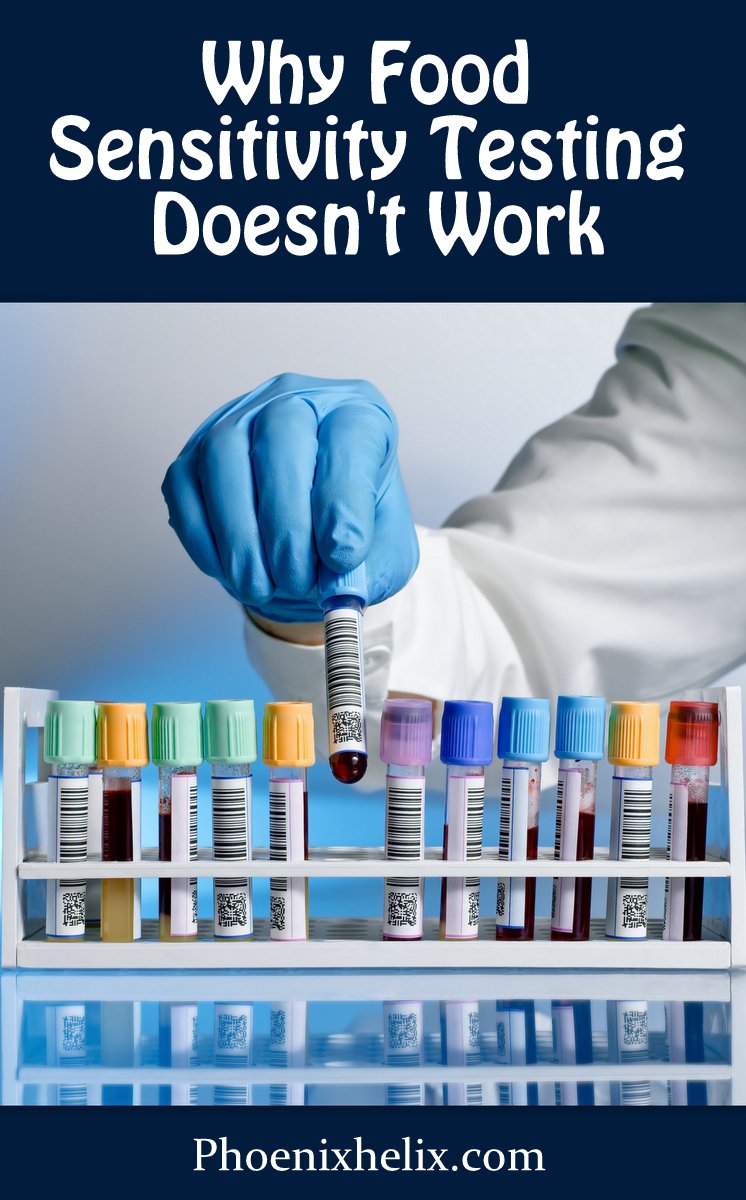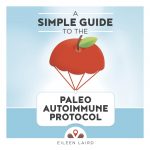
“If it sounds too good to be true, it probably is.”
~ Proverb
If Only It Were Easy
Let’s face it: the Paleo Autoimmune Protocol (AIP) is hard to do. If we could just take a test to identify our food sensitivities, it would be so much easier! So, why don’t we? Unfortunately, food sensitivity testing is unreliable, giving both false positive and false negative results. An elimination diet (like the AIP) is the only accurate way to test for them. It’s called the Gold Standard. This is actually one area where conventional doctors and paleo doctors agree. I realize that this can be very frustrating to hear if you’ve spent a lot of money on these tests already. Let’s delve into the science.
Food Allergies vs. Food Sensitivities
Food allergies are severe reactions that can even be life-threatening, sending someone to the hospital because they can’t breathe. You may know a child who has this reaction to peanuts. It’s frightening. There are two tests performed by allergists to diagnose food allergies: IgE blood test, and a skin test, both of which have proven scientific validity. Even so, allergists usually perform a food challenge in the office to confirm the diagnosis. Since allergic responses are fast and furious, the doctor is there to monitor the reaction.
Food sensitivities are a different matter. They are milder, but have a cumulative effect of provoking the immune system and increasing inflammation in the body. If you have autoimmune disease, food sensitivities exacerbate your symptoms, making them much worse. While there are tests sold to identify food sensitivities, they haven’t held up under scientific scrutiny. And because food sensitivity reactions are delayed, taking up to 72 hours to appear, a food challenge in a doctor’s office isn’t possible. Instead, an elimination diet (like the AIP) is the recommended route to diagnosis.
A Scientific Look at the Tests
ELISA and ALCAT are both blood tests that claim to identify food sensitivities. They look at how your blood responds when exposed to a specific food. ELISA measures IgG antibody reactions. ALCAT measures white blood cell reactions. These sound like plausible theories, right? Antibodies and white blood cells are part of your immune system. If your immune system reacts to a food, that would obviously signify sensitivity. Not so fast! The immune system is complex; if it wasn’t we’d have a cure for autoimmunity by now. It turns out that some studies show that an IgG response to a food actually indicates tolerance. And white blood cells constantly change shape and activity anyway, so if they do that in the presence of a food, that doesn’t mean the food was the trigger. Not surprisingly, both tests are notorious for inconsistent results. According to Chris Kresser, some doctors have sent in two blood samples for testing from the same person at the same time on the same day, and received different sensitivity reports. That’s why allergists around the world recommend against these tests and recommend an elimination diet like the AIP instead. Here’s a thorough report summarizing the research which has shown these tests are inaccurate.
What About Cyrex Labs?
This is a very respected lab within the paleo community, and they now offer a new food sensitivity test called Array 10 that is designed to be more accurate and is now recommended by many practitioners. Here’s the thing – it hasn’t been tested by an independent lab, so it’s an unproven technology and a very expensive test. Here’s a quote from Chris Kresser: “Despite the trust that I have in Cyrex and their methodology, I do still have some reservations about even this very high level IgG and IgA food sensitivity testing. Number one is that I think we need more research linking IgG food reactions to specific clinical manifestations….the direct clinical evidence that links food IgG testing to signs and symptoms is still a little bit murky.” If you absolutely want to try a food sensitivity test, this is your best choice, but don’t take the results as gospel. Use that to begin your elimination/provocation challenges. Also, keep in mind that if your Cyrex results show that you are sensitive to over half of the foods tested, that’s not about the foods. Instead, that indicates a loss of oral tolerance altogether. Listen to podcast episode 147 for more information on how to restore tolerance.
Elimination-Provocation: The Gold Standard for Testing Food Sensitivity
If an elimination diet is the only way to accurately test food sensitivity, how does it work? There are two phases: the elimination period (strict AIP) and the reintroduction period (also called provocation.) You follow a strict AIP diet for a minimum of 30 days until you see clear improvement in your autoimmune symptoms. This shows that healing has begun, and you can reintroduce foods one at a time, to test your body for tolerance. This process requires patience, but it’s 100% accurate and individualized to you. It’s where you learn to communicate with your body, and once you have that skill, you have it for life. It may not be easy, but it’s a powerful healing tool.
The Connection Between Leaky Gut and Food Sensitivity
Food sensitivities are often caused by intestinal permeability (aka leaky gut). Our intestinal lining is vital to our health. It’s designed to let needed nutrients into our bloodsteam, while keeping out everything that’s harmful to our health. Here’s the problem: leaky gut and autoimmune disease go hand in hand. You rarely find one without the other. With leaky gut, our intestinal lining becomes too permeable, letting things into our bloodstream that don’t belong there. Amino acids are a nutrient meant to be allowed through. They are the building blocks of proteins in our food, and the building blocks of cells in our bodies. They’re tiny and wonderful, and we need them. With leaky gut, our bodies let proteins through before they’ve been completely broken down into amino acids. We’re not talking big chunks of food – just molecules bigger than they should be, in a form our body can’t recognize as food. So, the body mounts a defense by activating the immune system and ramping up inflammation. Not a good situation for someone with autoimmune disease.
The Benefits of Doing the Hard Thing
The Paleo Autoimmune Protocol doesn’t just identify food sensitivities. The AIP has 3 pillars of healing: the foods we remove from our diet which are inflammation triggers, the foods we add to our diet that nourish and heal, and the lifestyle changes we make that balance our hormones and reduce inflammation bodywide. It’s a lot of effort, but the rewards are priceless. A lab test can’t do that.
One such reward is that the AIP is designed to heal and seal our gut lining. While food allergies are permanent, food sensitivities can be temporary. This is why, over time, many people are able to successfully reintroduce more and more foods.
“I’m not telling you it’s going to be easy.
I’m telling you it’s going to be worth it.”
~ Art Williams
What If I’ve Tried the AIP and My Autoimmune Symptoms Haven’t Improved?
First see if you’re making any of the Top 5 AIP Mistakes. Then, once you know you’re doing the AIP correctly, give yourself 3 months before troubleshooting further, because it can take time for the immune system to calm down and inflammation to recede. If after that time, you still haven’t improved, work with a good paleo functional medicine practitioner to do some testing – not food testing, but rather testing for things like hormone imbalances and gut infections. The answer isn’t to remove more foods, because we need deep nutrition to heal. The answer is to uncover the obstacles to our healing.
One last note: it’s possible for the body to get in the habit of inflammation. Our brain develops neuropathways that keep inflammation stimulated. There’s a program called DNRS that’s designed to rewire the brain in an anti-inflammatory direction. I’ve known many people who have expanded their food tolerance after following that program. Listen to podcast ep. 163 for details.
You May Also Be Interested In
A version of this post originally appeared as a guest post for Autoimmune Wellness.










I wonder how reliable the 588 dietary antigen A, G, E, and C is from Dunwoody Labs? I just paid $350 for this test so I hope it’s somewhat reliable. It measures both IgG and immune complexes containing the complement fragment complement (C3d) for multiple food antigens. I notice that many of the foods I’m intolerant to according to this test are foods also forbidden on the AIP such as black pepper, gluten, dairy, and eggs. I have a long list. My functional medicine doctor has balanced my hormones and my acupuncturist cured my candida infection. To finish my healing (and hopefully cure my psoriasis), it’s up to me to follow the food intolerance test results, get enough sleep, and manage my stress. I don’t know if I am skipping a step by not doing the AIP, though.
Hi Carolyn. It sounds like you have a good healthcare team on your side. What you’ve already done is wonderful, and you are so right that sleep and stress management are key. Unfortunately, I cannot guarantee that your food intolerance test results are accurate, for the reasons stated in the article. If you don’t see the results you hope for on your current diet, know that the AIP is always a future option for you. Also, if your tests showed you were intolerant to over half the foods tested, you might want to listen to a recent podcast I did on Oral Tolerance. There are root causes to address in that case, to expand your tolerance to a wider variety of foods: https://www.phoenixhelix.com/2020/05/01/episode-147-loss-of-oral-tolerance-with-dr-datis-kharrazian/
Dear Eileen
Do you have to have an auto immune disease to follow your exclusion diet?
I suffer terribly after eating certain foods very bloated and lethargic etc
If there is an elimination plan I could follow but not sure if I have an auto immune disease that would be absolutely fantastic
Thankyou so much
Jeannie
Hi Jean. Since you don’t have autoimmune disease, I recommend trying the GAPS diet. It’s designed to improve the very problems you describe. Here are some resources to help you learn more:
– The GAPS Diet book: http://amzn.to/1pEL0BV
– Meal Plans: http://bit.ly/1C52tKv
– You can also google the GAPS diet, and you’ll find lots of information online.
Any opinions about the MRT (Mediator Response Test)? I heard this test is accurate and seems to be well recommended in the online community. I also heard great things about the Cyrex array tests. In your opinion, which test would be the best?
Hi SF. I actually don’t recommend any type of food intolerance testing, including the ones you mention. Instead, I recommend an elimination diet like The Paleo Autoimmune Protocol. If you hit a plateau in your healing, there are other tests that I believe are more effective for health troubleshooting, and I outline them in this article: http://www.phoenixhelix.com/2016/04/30/how-to-find-a-good-functional-medicine-practitioner/
Thanks for pulling all these resources together, it is very informative. I just can’t figure out why a few months after successfully completing AIP reintroduction I have symptoms that return. This has occurred multiple times now. The main symptoms are EoE related, so I know it is a symptoms of a food I’m eating but can’t for the life of me figure out what. I might consider the Cyrex Array 10 just to have an additional metric to look at.
Becky, symptoms can have so many causes, and food really is just one of them. Stress, sleep, infections, hormone imbalances – all of those can cause symptoms to recur (and actually cause our bodies to become more sensitive to foods during those times of higher physical or emotional stress). So, definitely look in all of those areas in addition to the Cyrex Array 10. One more tip: Did you do the reintroduction process slowly and correctly, including the Stage 2 phase that identifies subtle food intolerances? I recommend using my Reintroduction eBook to guide your through the process, and you can also read my article: The Top 5 Mistakes People Make Reintroducing Foods, to see if any of those apply to you. They may not, I just wanted to share that information just in case.
Thank you so much Eileen! I followed the reintroduction protocol as described in Sarah Ballantyne’s “The Paleo Approach”. It sounds like I’m getting the “cumulative inflammatory response” that you described. I’ll try your approach this time around. It still amazes me how many different ways there are find health- thank you for your guidance.